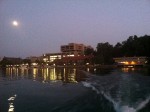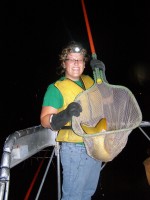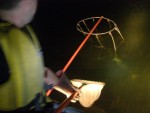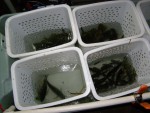Last fall, a small armada of boats slipped away from Hasler Lab’s dock and headed out on Lake Mendota well after sundown. Their objective was to add to a yearly census of fish populations in Lake Mendota, the largest lake in the Madison, Wisconsin chain of lakes and one of several Wisconsin lakes that make up a study area of the North Temperate Lakes (NTL) Long-Term Ecological Research program.
Besides Mendota, the southern Wisconsin lakes represented are Monona, Wingra and Fish Lake near Sauk City. Up north, the crew monitors Allequash, Sparkling, Trout, Big Muskellunge and Crystal Lakes, as well as two bogs—all near the University of Wisconsin Center for Limnology’s Trout Lake Research Station in Vilas County.
While all of these lakes are monitored year round for water chemistry, temperature and other parameters, the fish census only happens once each summer. And part of that census involves heading out at night when predatory fish move inshore to hunt.
Electrofishing involves dangling electrified wires into the water and giving the water in front of the boat a continuous jolt. Fish are momentarily stunned, float to the surface and are then netted out of the water by crew members standing at the bow.
Fish are kept in a large live well until they can be transferred to a “work up” boat where researchers record information like species ID, length, and weight before putting the fish back into the water.
The information is added to three decades’ worth of data, says senior LTER research specialist, Ted Bier. With data like this, Bier says, fisheries researchers can explore things like relative abundance and growth rates of fish or use it as a predictor of population cycles and to set management goals for the state’s important sport fisheries.
Up north, LTER fish crew data helped scientists examine the effect of invasive rainbow smelt on Crystal Lake fish populations. Since data on native populations of perch and walleye had been collected well before smelt invaded the lake, it was easy to chart the decline in their catch rates with each passing year’s fish census.
On this particular night on Lake Mendota, crew members pulled up some large walleye, a handful of freshwater drum, bullhead and bluegill, several large carp and lots of yellow perch.
The crew electrofished for half-hour stretches at three sites (and at the same spots ) designated for electrofishing since the LTER project began monitoring southern Wisconsin lakes.
At the end of each run, the “work up” boat pulled alongside the shock boat and transferred fish into their own live wells for sorting and data collection.
The crew worked well into the night counting and cataloging fish, finally calling it a night as the clock ticked from late Wednesday into early Thursday morning.
By the end of the night, the crew had cataloged hundreds of fish and added a little more data to the big picture of the long-term composition of Lake Mendota (and Southern Wisconsin’s) fisheries.

 Enlarge this image
Enlarge this image


